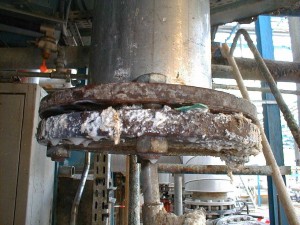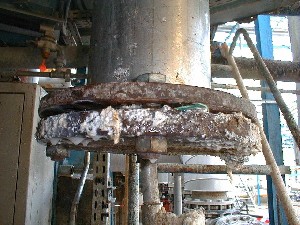340 kg of butadiene leaked from a 55 m³ reactor in a plant manufacturing ABS resins. Following pre-polymerisation tests (safety systems, reactor pressure test), 25 tonnes of water, emulsifying agent, an initiator and 15 tonnes of liquid butadiene under a pressure of 8 to 10 bar were added to the reactor. . The water temperature was raised to 80 °C.
The pressure inside the reactor normally goes from 10 to 3 bar with the reaction going on. The partial pressure of 3 bar indicates the end of the reaction and the butadiene that did not react is recovered by stripping. The reaction normally last up to 15 hours.
At 3.45 pm, while the polymerisation reaction had been underway for 90 minutes, a butadiene leak occurred in the lower part of the reactor at the blind flange located just after the pneumatic waste valve. The technicians in the control room are alerted of the sudden opening of the valve via an indicator. This was not a major problem for the operator as the circuit was closed by a protective cuff and a blind flange. The technicians tried to close the valve but did not succeed. One of them went to the reactor to manually close the valve but could not reach it due to the foam released from the lower part of the reactor. He smelt the characteristic odour of butadiene. At the same time, the leak activated the gas detector network, one of the gas detectors being situated vertically above to the reactor. Some detectors crossed the upper threshold of the alarm (40% of the LEL). The internal emergency plan was triggered and the operator decided to open the pressure relief valve of the reactor towards the flare circuit located on the reactor’s containment dome. The pressure of the latter decreased, stopping the leak in less than 30 min. The flaring lasted for 1 hour and 15 minutes. The detectors returned to their original state one hour after the start of the accident. The measurements made around the site revealed no contamination.
The accident analysis highlighted three concomitant factors: failure of the pneumatic waste valve with leakage at the O-ring of the push button controlling it resulting in a pressurisation and opening of the valve; the defect in the blind flange joint just after the valve; the inappropriate assembly of the blind flange with the wrong number of bolts and insufficient tightening. Moreover, no pressure test had been undergone on the equipment before. Subsequent to this accident, the facility was not re-commissioned. Polybutadiene production was carried out at another site of the group. Ever since, polybutadiene was supplied by road tankers. However, the prefectoral order dated 14/11/2000 subjected the possible re-commissioning of the unit to compliance with certain provisions on risk prevention planning, implementing clear operating guidelines, preventive maintenance of facilities, regular inspection of safety devices, piping network of the facilities and vital safety equipment.
Download the detailed report in .pdf format (443 Kb)





